|
|
|
[INDEX]
CD Reviews: Piau's Mozart Arias, Rostropovich Master Cellist, Three Tenors, Voice of Mozart, Yundi Li's Chopin, Bach Collegium Japan Cantatas Vol. 17, Rattle's Gurrelieder, Dvorak's Slavonic Dances (Fischer and Harnoncourt)
By Philip Anson / June 20, 2002
On the Aisle |  |
Mozart Opera Arias
Sandrine Piau / Freiburger Barockorchestra
Astrée Naive E8877 (64.14)
5 stars $$$
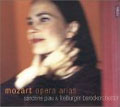 This
ravishing disc is an auspicious beginning to French soprano Sandrine Piau’s
exclusive contract with Astrée Naive. She offers marvellous performances
of seven arias drawn from Mozart’s operas Mitridate, re di Ponto, Lucio
Silla, Il re pastore, and La Clemenza di Tito, among others. Piau and
the Freiburger Barockorchestra under their conductor and artistic director
Gottfried von der Goltz perform Mozart with a light, transparent touch.
This is how most period instrument bands interpret Handel and Monteverdi
these days and it serves Mozart well - a refreshing change from the loud,
stressfull, swampy Mozart performances offered by symphonic orchestras
and screeching can belto sopranos in 4000-seat opera houses. Thus “Ach,
ich fühls” (Die Zauberflöte) and “Traurigkeit” (Die Entführung as dem
Serail) are not just vocal gymnastics but truly affecting laments. The
lullaby “Ruhe, sanft” from Zaïde will leave a lump in your throat. This
is Mozart as the composer intended it to sound. Piau’s voice is glittering,
accurate, personable, warm and velvety - a blend of many of the best qualities
of Nathalie Dessay’s soprano and Cecilia Bartoli’s mezzo, without their
eccentricities. Piau’s German and Italian diction is excellent. The recording
made at the Théâtre de Poissy boasts ideal clarity, balance and presence.
Highly recommended. This
ravishing disc is an auspicious beginning to French soprano Sandrine Piau’s
exclusive contract with Astrée Naive. She offers marvellous performances
of seven arias drawn from Mozart’s operas Mitridate, re di Ponto, Lucio
Silla, Il re pastore, and La Clemenza di Tito, among others. Piau and
the Freiburger Barockorchestra under their conductor and artistic director
Gottfried von der Goltz perform Mozart with a light, transparent touch.
This is how most period instrument bands interpret Handel and Monteverdi
these days and it serves Mozart well - a refreshing change from the loud,
stressfull, swampy Mozart performances offered by symphonic orchestras
and screeching can belto sopranos in 4000-seat opera houses. Thus “Ach,
ich fühls” (Die Zauberflöte) and “Traurigkeit” (Die Entführung as dem
Serail) are not just vocal gymnastics but truly affecting laments. The
lullaby “Ruhe, sanft” from Zaïde will leave a lump in your throat. This
is Mozart as the composer intended it to sound. Piau’s voice is glittering,
accurate, personable, warm and velvety - a blend of many of the best qualities
of Nathalie Dessay’s soprano and Cecilia Bartoli’s mezzo, without their
eccentricities. Piau’s German and Italian diction is excellent. The recording
made at the Théâtre de Poissy boasts ideal clarity, balance and presence.
Highly recommended.
Rostropovich Mastercellist: Legendary Recordings 1956-1978
DG 471 620 (2 CD 133. 43)
5 stars $$$
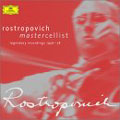 Russian
cellist Mstislav Rostropovich (b. 1927) is indisputably one of the great
cellists of the century. As a non-person under Soviet rule, he uniquely
combined political celebrity with musical genius and has been duly sanctified
in the Commie-hating West since his exile from the USSR in 1974. This
2-disc homage celebrating his 75th birthday is a fine tribute. The 1968
recording of Dvorak’s Cello Concerto reveals a soloist positively ecstatic
in the Allegro, though almost overwhelmed by Karajan’s grandiose, domineering
Berlin Philharmonic. The 1960 Schumann Concerto recording with the Leningrad
Philharmonic suffers a bit from the crude brassiness and orchestral theatrics
of conductor Rozhdestvensky, but Rostropovich offers a meaty, ambitious,
engaged reading. Two Russian works - Tchaikovsky’s Andante cantabile (with
the Berlin Philharmonic conducted by the cellist, 1978) and Glazunov’s
Chant du ménéstrel (Ozawa, Boston Symphony Orchestra, 1975) are up to
the mark. The second disc is all chamber music with his longtime pianist
Alexander Dedyukhin, recorded in Warsaw in 1956, the year of his New York
and London debuts. The acoustics and balance of these early recordings
are not top drawer, but collectors will treasure the first appearance
on CD of the Rachmaninov Vocalise Op. 34 No. 14, Schubert Impromptu D.
899 No. 3, and Schumann’s Träumerei Op. 15 No. 7. This collection was
drawn exclusively from the Deutsche Grammophon back catalogue so excludes
many recordings Rostropovich made for other labels, but it is still worth
the time and money. Notes in English, French, German. Russian
cellist Mstislav Rostropovich (b. 1927) is indisputably one of the great
cellists of the century. As a non-person under Soviet rule, he uniquely
combined political celebrity with musical genius and has been duly sanctified
in the Commie-hating West since his exile from the USSR in 1974. This
2-disc homage celebrating his 75th birthday is a fine tribute. The 1968
recording of Dvorak’s Cello Concerto reveals a soloist positively ecstatic
in the Allegro, though almost overwhelmed by Karajan’s grandiose, domineering
Berlin Philharmonic. The 1960 Schumann Concerto recording with the Leningrad
Philharmonic suffers a bit from the crude brassiness and orchestral theatrics
of conductor Rozhdestvensky, but Rostropovich offers a meaty, ambitious,
engaged reading. Two Russian works - Tchaikovsky’s Andante cantabile (with
the Berlin Philharmonic conducted by the cellist, 1978) and Glazunov’s
Chant du ménéstrel (Ozawa, Boston Symphony Orchestra, 1975) are up to
the mark. The second disc is all chamber music with his longtime pianist
Alexander Dedyukhin, recorded in Warsaw in 1956, the year of his New York
and London debuts. The acoustics and balance of these early recordings
are not top drawer, but collectors will treasure the first appearance
on CD of the Rachmaninov Vocalise Op. 34 No. 14, Schubert Impromptu D.
899 No. 3, and Schumann’s Träumerei Op. 15 No. 7. This collection was
drawn exclusively from the Deutsche Grammophon back catalogue so excludes
many recordings Rostropovich made for other labels, but it is still worth
the time and money. Notes in English, French, German.
Chopin Recital
Yundi Li, piano
DG 471 479 2 (67.00)
5 stars $$$
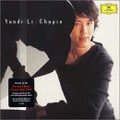 This
is an extremely promising debut CD by 19-year old Chinese pianist Yundi
Li. The first musician in 15 years to be awarded first prize at the Warsaw
Chopin Piano Competition, Li seems to have concentrated on the music of
Chopin thus far in his career. This recording reveals a remarkable touch,
full of body and soul. The Allegro of Piano Sonata No. 3 in B minor, Op.
58, is tender and voluptous. Li demonstrates good "jeu perlé"
in the Scherzo and Finale, though the largo is too languid. Li’s rich
sound and dreamy impressionistic tone can get a bit cloying. His pert,
detached, delicate fingering recalls Horowitz, though unlike Vladimir
he never thunders. He lacks that drop of Liberace blood which adds zest.
The six etudes and nocturnes are played with even-handed control but a
bit rigidly, as if for an academic competition. Li is extremely talented,
but must diversify before he can be called a rounded artist. His career
is probably assured, and it doesn’t hurt that he is marketably handsome
and not ashamed to vamp for the camera. The cd booklet and packaging offer
16 photos of Li ranging from Vogue to beefcake (or is that ricecake?).
The next few years should see an interesting showdown between Li and the
other teenage Chinese prodigy du jour, Telarc’s Lang Lang. This
is an extremely promising debut CD by 19-year old Chinese pianist Yundi
Li. The first musician in 15 years to be awarded first prize at the Warsaw
Chopin Piano Competition, Li seems to have concentrated on the music of
Chopin thus far in his career. This recording reveals a remarkable touch,
full of body and soul. The Allegro of Piano Sonata No. 3 in B minor, Op.
58, is tender and voluptous. Li demonstrates good "jeu perlé"
in the Scherzo and Finale, though the largo is too languid. Li’s rich
sound and dreamy impressionistic tone can get a bit cloying. His pert,
detached, delicate fingering recalls Horowitz, though unlike Vladimir
he never thunders. He lacks that drop of Liberace blood which adds zest.
The six etudes and nocturnes are played with even-handed control but a
bit rigidly, as if for an academic competition. Li is extremely talented,
but must diversify before he can be called a rounded artist. His career
is probably assured, and it doesn’t hurt that he is marketably handsome
and not ashamed to vamp for the camera. The cd booklet and packaging offer
16 photos of Li ranging from Vogue to beefcake (or is that ricecake?).
The next few years should see an interesting showdown between Li and the
other teenage Chinese prodigy du jour, Telarc’s Lang Lang.
Bach: Cantatas Volume 17
M. Suzuki / Bach Collegium Japan
BIS CD-1221 (66.53)
4 stars $$$
The Bach Collegium Japan, founded in 1990 by Masaaki Suzuki, has quickly
consolidated its place as one of the premiere Bach orchestras in the world.
Their recordings since 1995 of Bach’s canatas, Christmas Oratorio and
the St. John Passion, have been consistently excellent. To the shame of
British and German musicians, these Japanese have set the standard for
Bach performance in our time. The 17th volume of their complete cantatas
recording project is up to the mark. The five Leipzig cantatas on this
disc - BWV 153, BWV 154, BWV 73, BWV 144, BWV 181 - date from January
and February 1724. As usual Suzuki has hired excellent European singers
for the solo parts: German tenor Gerd Türk, English countertenor Robin
Blaze, and Dutch bass Peter Kooij. Blaze’s fresh, sweet countertenor is
particularly pleasant and adds sun to the charming duet “Wohl mir, Jesus
ist gefunden” from BWV 154 with the clean, high tenor Türk. Kooij has
a noble bass with crisp diction. Japanese soprano Yukari Nonoshita, deploying
a high, dry voice, makes a brief appearance. The nine-member Japanese
choir has a pure, affecting sound as good or better than the best European
product. The period instrument playing is delicious and the recorded sound
is perfectly balanced and lightly resonant, as usual. Excellent scholarly
notes in Enlgish, French and German. Highly recommended.
Schoenberg: Gurrelieder
Rattle/Berlin Philharmonic
EMI 724355 730329 (2 CD-110.14)
3 stars $$$
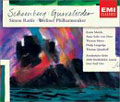 Having
heard Sir Simon Rattle conduct Schoenberg’s massive Gurrelieder at Carnegie
Hall a few years ago, I expected great things of this new recording. Alas
Gurrelieder, with its massive neo-Wagnerian orchestration and multiple
choirs calling for some 400 musicians and singers, is not easy to capture
on disc. EMI’s engineers seem to have played it excessively safe. In a
live Gurrelieder performance, Schoenberg’s rapid switching from delicate
instrumental effects to massive walls of sound, lachrimose arias, spooky
choruses and dramatic narratives is a wild trip. Inexplicably, EMI’s engineers
have tamed this musical rollercoaster ride, flattening out the sprawling
orchestra, dynamic range, and the army of choristers into a smooth, homogenous,
unexciting soundscape. The recording made in the Berlin Philharmonie is
genteel and detailed, but everyone sounds distant, as if behind glass.
The trouble is compounded by inadequate casting. German tenor Thomas Moser
does his best with the Heldentenor demands of Waldemaar, but he never
gets inside the role. His love song, “Mit Toves Stimme” is unmoving. Tove
is sung by ice queen Finnish soprano Karita Mattila who sounds dry and
breathy. Swedish mezzo Anne Sofie von Otter ruins the Wood Dove’s sublime
lament. Her cry “Tot is Tove” (“Tove is dead”) is unforgivably apathetic.
German baritone Thomas Quasthoff makes a nice cameo as the Peasant and
Sprecher. Philip Langridge is an excellent Klaus Narr. The Rundfunkchor
Berlin, MDR Rundfunkchor Leipzig, and Ernst Senff Chor Berlin are superb
but the recording fails to give them enough presence. Notes and texts
in English, French, and German. Having
heard Sir Simon Rattle conduct Schoenberg’s massive Gurrelieder at Carnegie
Hall a few years ago, I expected great things of this new recording. Alas
Gurrelieder, with its massive neo-Wagnerian orchestration and multiple
choirs calling for some 400 musicians and singers, is not easy to capture
on disc. EMI’s engineers seem to have played it excessively safe. In a
live Gurrelieder performance, Schoenberg’s rapid switching from delicate
instrumental effects to massive walls of sound, lachrimose arias, spooky
choruses and dramatic narratives is a wild trip. Inexplicably, EMI’s engineers
have tamed this musical rollercoaster ride, flattening out the sprawling
orchestra, dynamic range, and the army of choristers into a smooth, homogenous,
unexciting soundscape. The recording made in the Berlin Philharmonie is
genteel and detailed, but everyone sounds distant, as if behind glass.
The trouble is compounded by inadequate casting. German tenor Thomas Moser
does his best with the Heldentenor demands of Waldemaar, but he never
gets inside the role. His love song, “Mit Toves Stimme” is unmoving. Tove
is sung by ice queen Finnish soprano Karita Mattila who sounds dry and
breathy. Swedish mezzo Anne Sofie von Otter ruins the Wood Dove’s sublime
lament. Her cry “Tot is Tove” (“Tove is dead”) is unforgivably apathetic.
German baritone Thomas Quasthoff makes a nice cameo as the Peasant and
Sprecher. Philip Langridge is an excellent Klaus Narr. The Rundfunkchor
Berlin, MDR Rundfunkchor Leipzig, and Ernst Senff Chor Berlin are superb
but the recording fails to give them enough presence. Notes and texts
in English, French, and German.
Dvorak: Slavonic Dances
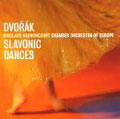 Two
new recordings of Dvorak’s ever-popular sets of Slavonic Dances Op. 46
and Op. 72 have appeared simultaneously. You might expect Hungarian Iván
Fischer and the Budapest Festival Orchestra to have the inside track on
music by Czech composer Anton Dvorak. But their new recording (Philips
289 464 012) is beaten hands down by the startlingly fresh, smart and
sexy new recording by Nikolaus Harnoncourt and the Chamber Orchestra of
Europe (Teldec 8573810382 - pictured left). Fischer’s spunky/sloppy performances
offer in digital sound the traditional blowsy, waltzy version of this
music. If we want that fanmiliar grand old Austro-Hungarian-style Dvorak,
there are plenty of "classic" recordings to choose from. Paradoxically
Harnoncourt, who has only been playing Dvorak since 1999, offers a revolutionary
interpretation stripped of clutter and bombast. His orchestral textures
are light and transparent. His percussion and brass is lean and glittering.
With the rest of the orchestra in check, the winds are audible and savoury.
The Chamber Orchestra of Europe’s playing is robust and detailed, without
a single false step, imbalance, or error of taste. Fischer’s 1999 recording
was made at the Italian Institute, Budapest, and has an airbrushed, distant
acoustic. Harnoncourt’s recording made in the Stefaniensaal, Graz, in
2000/2001 is close and vital, as if one were in the room. Fischer’s Dionysian
reading (3 stars) leaves one uneasy and satiated while Harnoncourt’s Apollonian
vision (5 stars) seduces and delights.Both versions have notes in German,
English and French. Two
new recordings of Dvorak’s ever-popular sets of Slavonic Dances Op. 46
and Op. 72 have appeared simultaneously. You might expect Hungarian Iván
Fischer and the Budapest Festival Orchestra to have the inside track on
music by Czech composer Anton Dvorak. But their new recording (Philips
289 464 012) is beaten hands down by the startlingly fresh, smart and
sexy new recording by Nikolaus Harnoncourt and the Chamber Orchestra of
Europe (Teldec 8573810382 - pictured left). Fischer’s spunky/sloppy performances
offer in digital sound the traditional blowsy, waltzy version of this
music. If we want that fanmiliar grand old Austro-Hungarian-style Dvorak,
there are plenty of "classic" recordings to choose from. Paradoxically
Harnoncourt, who has only been playing Dvorak since 1999, offers a revolutionary
interpretation stripped of clutter and bombast. His orchestral textures
are light and transparent. His percussion and brass is lean and glittering.
With the rest of the orchestra in check, the winds are audible and savoury.
The Chamber Orchestra of Europe’s playing is robust and detailed, without
a single false step, imbalance, or error of taste. Fischer’s 1999 recording
was made at the Italian Institute, Budapest, and has an airbrushed, distant
acoustic. Harnoncourt’s recording made in the Stefaniensaal, Graz, in
2000/2001 is close and vital, as if one were in the room. Fischer’s Dionysian
reading (3 stars) leaves one uneasy and satiated while Harnoncourt’s Apollonian
vision (5 stars) seduces and delights.Both versions have notes in German,
English and French.
The Best of the Three Tenors
Decca 466 999 2 (64.25)
1 star $$$
This album is a study in the depths to which classical music labels and
singers will go to turn a dollar. The oily liner notes are full of exaggerations
and fibs that distort the history of the Three Tenors phenomenon, its
financial motivation and poor critical reception. Far from being the “best
of” the Three Tenor Concerts in Rome 1990, Los Angeles 1994, and Paris
1998, this is a schmeer of medleys we’ve heard a hundred times before.
The hook, if you can call it that, is that all three singers appear on
all 22 tracks. There are no solo songs or arias, alas. Alas, because Domingo,
Carreras, and Pavarotti bring out the worst in each other when singing
"a duè" and "a trè". Witness their atrocious vocal
skirmishes, echo effects, high-note-capping and barbershop quartet harmonizing.
It is a wonder how these artists, who can be worthy opera soloists when
apart, become so vulgar as a trio. The repertiore is mostly Italian songs
and Broadway show tunes mangled by the artists' phonetic sight reading.
Only two tracks can be called classical: La donna è mobile and Nessun
dorma - but these opra arias are so distorted as to be almost unrecognizable.
The slobbering, hysterical arrangements and “medley bridges” by Lalo Schifrin
bespeak the degraded taste of the masses who have paid millions for this
musical miscegenation. Let’s hope this is the last squeeze of the teat
of Tibor Rudas’s aging cash cow.
The Voice of Mozart
Decca 289 470 505 2 (136.77)
5 stars $$
This treasurable 2-CD compilation of Mozart opera arias, songs, and sacred
music from the Philips and Decca back catalogue offers great singers singing
great music. Stars to be heard on the 38 tracks include Te Kanawa, Berganza,
Ramey, Auger, Leontyne Price, Schreier, Moll, Mattila, Hendricks, and
von Otter. Highlights include Terfel and Bartoli’s 1999 Papageno-Papagena
duet; Kathleen Battle’s sunny 1987 “Welche Wonne”; the duet “Ah, perdona
al primo affeto” sung deliciously by Frederica von Stade and Lucia Popp;
José van Dam’s “Se vuol ballare”; and two songs sung by Elly Ameling.
About the only drawback is the insert booklet which contains no notes
or texts though there are three blank pages where useful information could
have been printed. Top quality performances of Mozart favorites and rarities
in fine sound on generously filled mid-price discs make this a highly
recommendable offering.
[INDEX]

|
|
|


